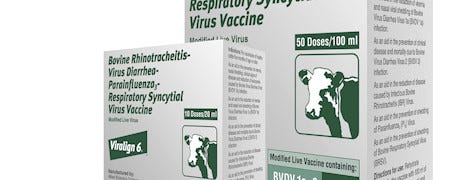October 9, 2013

USDA has issued the Veterinary Biological License for Elanco’s Viralign 6, the first combination modified-live virus vaccine to provide targeted protection against bovine viral diarrhea virus 1b
“Even though producers have vaccinated for the BVD virus for years, research shows its incidence has not gone down and 1b has replaced 1a as the most predominant BVD strain,” says veterinarian Carl Guthrie, director of Elanco beef technical services.
In fact, Guthrie says the 1b strain is now the most predominant BVD virus strain in the US.

NEW STRAIN: Elanco’s Viralign 6, a combination modified live vaccine, is designed to prevent the newly dominant strain of BVD known as the 1b strain.
Viralign 6 also provides protection against BVD viral strains 1a and 2, bovine respiratory syncytial virus (BRSV), infectious bovine rhinotracheitis (IBR) virus and parainfluenza3 (PI3) virus.
“Until now, veterinarians and producers have relied on combination vaccines with BVD 1a and 2 to cross-protect against … 1b,” Guthrie says. “We are pleased that Elanco’s debut cattle vaccine is the very first USDA-approved MLV vaccine to include antigens for all three major BVD viruses, including 1b.”
This first-of-its-kind vaccine enables low-volume, subcutaneous administration in cattle 5 months of age or older. As with other MLV BVD vaccines, it must not be given to pregnant cows or calves nursing pregnant cows since the modified virus could cause abortions. Full instructions are on the label.
Guthrie says, “The good news is that ongoing vaccination programs appear to have decreased the predominance of 1a in the United States. But it also suggests current modified-live 1a vaccines may not adequately protect calves from 1b infections. Since BVD is the most costly viral disease in cattle, Viralign 6 is an important herd-health tool that will help combat all three major BVD strains.”
The BVD virus is an RNA virus, which means it is more susceptible to mutation. That’s why researchers monitor BVD viral strains to identify changes in predominance.
In fact, a USDA Agriculture Research Service analysis of diagnostic samples shows there has been a shift in predominance of BVD viral strains in the United States. In 1988, subtype 1a was predominant at 51%. Twenty years later, 1a ranked third at 18% while subtype 1b had increased in predominance from 41% to 61%. At the same time 1a was decreasing the overall incidence of BVD virus did not decline.
“One of the primary sources of the BVD virus is exposure to persistently infected (PI) animals — cattle that are few in number but shed large amounts of the virus throughout their lives,” says veterinarian Brad Williams, Elanco senior technical consultant. “Comprehensive research involving 21,743 head shows that 78% of PI cattle were infected with [strain] 1b.”
Another study showed calves exposed to a PI calf are 43% more likely to require treatment for BRD. Further, due to the immune-suppressing nature of BVD, cattle might not show signs of infection even though they suffer from subclinical respiratory and other profit-robbing diseases.
The USDA has reviewed studies documenting no adverse effects attributable to Viralign 6. Additional research shows calves vaccinated with Viralign 6 and then exposed to BVD strain 1b had no clinical signs of BVD, unlike their control counterparts — 80% of which showed signs including diarrhea, nasal discharge, rapid respiration and watery eyes.
Viralign 6 is available in 10-dose and 50-dose packages through veterinarians and animal-health distributors. For information contact your Elanco sales representative or technical consultant, or visit the Viralign 6 product page.
You May Also Like




